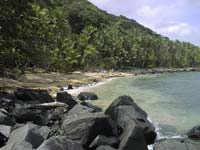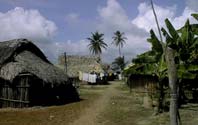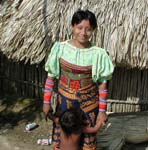|
12 November
2000 Isla Piños, San Blas, Panama
9*00.012N, 077*45.621
We have sailed
into the pages of National Geographic. This is what the adventure
of cruising is really all about - seeing places and meeting people
who really live differently than we do. We have been in the San
Blas islands only four days, and already we are overflowing with
experiences!
 We
made "landfall" at Isla Piños (or Tupbak in Kuna,
which means beached whale), a big mound of an island with clear
entry through offshore reefs. The anchorage is a perfect picture,
placid green water, a shore fringed by neat coconut palms, dugout
canoes paddling silently. The mainland across the channel rises
in layered hills to a mountainous spine, reminiscent of Vermont,
or better yet, the Blue Ridge Mountains, because there always seems
to be wisps of cloud and mist in the folds. We
made "landfall" at Isla Piños (or Tupbak in Kuna,
which means beached whale), a big mound of an island with clear
entry through offshore reefs. The anchorage is a perfect picture,
placid green water, a shore fringed by neat coconut palms, dugout
canoes paddling silently. The mainland across the channel rises
in layered hills to a mountainous spine, reminiscent of Vermont,
or better yet, the Blue Ridge Mountains, because there always seems
to be wisps of cloud and mist in the folds.
Before I go
on, I need to tell you a little about Kuna Yala, the almost autonomous
nation of indigenous Indians that inhabit the San Blas archipelago.
The Kuna tribes moved from the mountains to the coast about the
time of the Spanish occupation, ie the 1600s. Even so, they suffered
the same violent inroads that most other indigenous peoples suffered
during colonization by outsiders. Panama itself only seceded from
Gran Colombia in 1903, and they did so only with the support of
the US, who by then were committed to building a canal. The canal,
to give you a frame of reference, opened in 1914. An independent
Panama was no kinder to the Kuna and 1925 they finally rebelled,
violently. Interestingly, it was intervention by the US that prevented
retribution, and by 1938 the Kuna were granted an almost autonomous
rule enabling them to maintain their traditional lifestyle. Speaking
off the cuff, it looks to us like they got a better deal than theAmerican
Indians!
There are three
districts in the Comarca de San Blas, the region's official name,
and each is governed by a high chief called a cacique (pronounced
ka-see-kay). There are 49 communities, each of which has a sahila
(pronounced sigh-la) , and below him continues downward a hierarchy
of "deputy" sahilas plus a secretary who interpret between
Kuna and Spanish and who keep track of all the permits. You can't
do anything in San Blas without the sahila's permission, and all
permits cost. This applies not just to cruisers, but to the Kuna
themselves. Simply wanting to travel between islands require a permit.
For us it means we must ask for permission to anchor, tour the island,
explore a river, etc. and for the privilege we pay out our fees,
usually about $6 per island. In a rather bizarre irony, here in
this most different of cultures, the currency is the US dollar!
We'd all read
the guidebooks, but you never are exactly sure how things work for
real, for example do you need to pay if you just anchor. Fortunately,the
fisherman in the dugouts, called ulus, inched closer and closer
to us until communications began and we learned, in tentative Spanish
and, surprisingly, a little English, that indeed we did need permission
to anchor. (We learned later that a boat a head of us had slipped
in and out, dodging the ritual, so things were a little extra sensitive!)
So, after a nap we and our friends (3 other yachts made the trip
across with us) went ashore to see the sahila.
 The
main village of Piños was just around a bend from our anchorage.
There was a long cement dock to accommodatesupply boats and a small
cement store, but everything else is built of cane sticks for walls
and thatch roofs. On the dock we were met by several Kuna, including
an exuberant young man named David who had a fair amount of English
who undertook to guide us to the sahila. The houses cluster close
together and we all had to dodge eaves designed for a shorter population. The
main village of Piños was just around a bend from our anchorage.
There was a long cement dock to accommodatesupply boats and a small
cement store, but everything else is built of cane sticks for walls
and thatch roofs. On the dock we were met by several Kuna, including
an exuberant young man named David who had a fair amount of English
who undertook to guide us to the sahila. The houses cluster close
together and we all had to dodge eaves designed for a shorter population.
Sahila Julian
Gonzalez received us graciously, shaking each of our hands before
collecting the money. We later learned that this sahila will be
a cacique next year! His house was no different than the others,
but very tidy. The cooking fire out the back scented the air with
a light smoke, children hung in several hammocks suspended from
the rafters, ears of corn were stacked overhead, coconut piled in
a corner and the floor was neatly swept dirt. There are no windows,
but light comes through the walls.
We received
permission to hike around the island, which we set up with young
David for the next day . But the next day brought rain, so we postponed.
The following day we had to wait on shore for David until he caught
his required seven fish for his family! We could have gone sooner
if we'd had any fish to give him. The men of the island have a work
quota divided between fishing and agriculture to provide subsistence
for their families. Once that's done they're done! He and Treciliano,
a 14-year-old also with some English took us on a two-hour circumnavigation
of the shoreline. Although there is no property ownership per se,
and although all the residents live in the village, all the coconut
trees on the island no matter how distant belong to someone. David,
for example, pointed out his clump, about a third of the way around
the north side. Unfortunately his English did not go far enough
for us to be clear if he just owned two or three trees at this remote
section of the island and how he came to have them. We do know that
it is a serious offense to pick up a stray coconut. It is like picking
up quarters. We actually watched little girls and old men buy cold
Pepsis at the store for 3 coconuts!
After our hike,
a couple dozen women brought out their molas for us to inspect.
Molas, THE cash industry of the San Blas, are a very unique kind
of embroidery worked on layers of colored fabric that are cut away
to make patterns and pictures which are then embroidered. The handwork
is phenomenal. The molas are part of the women's elaborate and colorful
traditional dress, which stands out all the more for the fact that
the men dress American drab - shorts and T-shirt for everyday, while
the more formal sahilas wear long pants, cotton shirts and felt
dress hats! Generally the women wear two layers of skirt, the top
one a black and gold wrapt, topped by blouses of mixed bright patterns,
of which the molas make up the front and back panels. On their heads
the woman wear red kerchiefs, and their ankles and wrists are bedecked
with 6"-wide bead bracelets making fancy patterns plus gold
necklaces, a gold nose ring, and usually some face decoration. The
molas laid out on the ground for us to shop from were amazingly
varied, the designs evidently up to the seamstress's fancy. Crabs,
lobsters, fish, and birds are common motifs, although there is some
influence from outside - our friend Sam bought one of a cowboy on
his horse! Many are just rectangles about placemat-size, but others
are still in whole blouses, right out of the "closet"
(which in Kuna houses is the rafters). A single mola panel will
usually sell for $10-20, a blouse for $30-40. We bought two blouses,
for $30 apiece, not that either one of them could ever fit me; (I
am definitely a Gulliver in Lilliput-land.) Selling a mola is a
big economic coup, and mola sales are usually not so organized.
In Piños, both before and after the "sale," we
had several women, sometimes with husbands, sometimes with kids,
paddling out to the boat repeatedly in the hopes of catching us
in a weak moment. And it would seem there is politics involved too,
as several men tried to sell us molas and the sahila was notto know!
 By
our third day in Piños we had a widening circle of people
we knew by name! There was Yolanda, who soldme my firstmola and
a bead bracelet for my ankle. There was David and Treliciano, who
persuaded us to let them visit the boat. There was Suarez who wanted
a photo portrait of his wife, which George of SueThing took and
we printed, and Horatio, who invited Don in to sign his scrapbook
of visitors. And everywhere there were children. Little ones who
shriek "Hola!" til they get your attention, then scurry
away in giggles when you turn. Don was a big hit with kids, and
I don't think it entirely had to do with the pocketful of sweets
he had handy. By
our third day in Piños we had a widening circle of people
we knew by name! There was Yolanda, who soldme my firstmola and
a bead bracelet for my ankle. There was David and Treliciano, who
persuaded us to let them visit the boat. There was Suarez who wanted
a photo portrait of his wife, which George of SueThing took and
we printed, and Horatio, who invited Don in to sign his scrapbook
of visitors. And everywhere there were children. Little ones who
shriek "Hola!" til they get your attention, then scurry
away in giggles when you turn. Don was a big hit with kids, and
I don't think it entirely had to do with the pocketful of sweets
he had handy.
Our fourth morning
in Piños we were invited to a Chi Chi Party. There is a special
Chi Chi hut in every village, big enough to accommodate everyone.
The event being celebrated was a girl's coming of age. The party
means a day off for everyone, which is good because the major activity
is getting drunk! The party started at 7am! Six of us arrived at
7:30. Already there was a definite glow on most of the faces, and
everywhere were cigarettes! We'd seen no smokers previously. It
turned out they believe that smoking will prevent vomiting! This
is because they don't drink normally, either!
Inside the hut,
the men and women were separated. The men sat on chairs and benches
and while the women had hammocks at hand. Don was the first to figure
out the routine. About five or six men would fill calabash bowls
with the chi chi fuerte (like whiskey, we were told) from the earthenware
crocks buried in the ground where it had been fermenting for a month.
Against the opposite wall was a bench with five or six guys waiting.
The guys with the bowls would give a shout, the guys on the bench
would leap to meet them and the two lines would dance back and forth
whooping in a quite an "Indian" fashion. Two passes and
the new guys got the bowls to drink down the chi chi. Once done,
the new guys rinse the bowls and refill them, while another six
guys fill in the bench. After several rounds, the calabash bearers
would turn
and serve the sahilas, who remained sitting dignified in their chairs,
around the fire which kept the hut filled with a fine smoke!. At
the other end of the hut the women did much the same thing, only
more quietly and with smaller bowls. The women, by the way, were
all dressed identically with same color blouses and brand new molas,
more jewelry and more face paint!
Eventually we
were asked if we would like to partake! The guys were game (we were
in the guy section) and the sahila gave permission (no fee!). Bowls
were brought and the guys did their best to gulp it down. Don gave
a little whoop which pleased everybody. The "whiskey,"
they reported, was more like a coffee-flavored wine! Not long after,
the ladies were asked if we'd like to partake! Over we went to the
ladies' side, and with much merriment we were presented with our
bowlfuls. They may have been smaller calabashes, BUT there had to
be 8oz of the stuff in there! We danced a little for the ladies
which made their day, and shortly after beat a retreat! Yikes! All
this and it wasn't 9am yet!
After a little
rest and a little coffee, Don and I couldn't ignore the clearing
sky, so leaving our buddy boats behind, we upped anchor and headed
north. For you see we have committed the cardinal sin of cruising.
We have a rendezvous to make by December 2 with our friends Diane
and Alex who will be flying in. Amazingly there are airstrips all
through these islands - thanks to the US military - and although
anyplace along the archipelago would be a great experience, the
diving is said to be better in the northwest, so we are doing our
best to get up there.
|